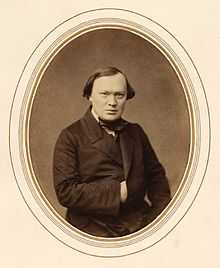A Protégée of the Mistress
| A Protégée of the Mistress | |
|---|---|
| Written by | Aleksander Ostrovsky |
| Date premiered | 21 October 1863 |
| Place premiered | Maly Theatre in Moscow |
| Original language | Russian |
| Genre | Social drama |
A Protégée of the Mistress (Vospitannitsa, Воспитанница; also, The Ward Girl) is a play by Alexander Ostrovsky, first published in the #1, January 1859 issue of Biblioteka Dlya Chteniya. In October 1859 it was banned from being staged by Imperial theatres, and was premiered in Maly Theatre, Moscow, on October 21, 1863.[1]
History
Ostrovsky conceived A Protégée of the Mistress in 1855 as a play in two acts. On July 12 of that year he made a rough draft of Act 1 and compiled the list of characters, but the next day stopped working upon it. Some characters of this initial version, like retired official Zakhar Zveroboyev and merchant Savva Bruskov, were later excluded from the scheme. The original title of the play was "Game for a Cat, Tears for a Mouse" (Koshke igrushki, myshke slyozki), with a subtitle "Pictures of Rural Life".[1]
In an April 21 letter to Alexander Druzhinin Ostrovsky promised to finish it quick and bring to Saint Petersburg but this promise remained unfulfilled. The play was finished only on December 7, 1858 but continued to be changed by the author for months to come.[1] On September 26, 1859, A Protégée of the Mistress was approved by the Theatre and Literature committee but not unanimously: the chairman S.P.Zhikharev and A.G.Rogchev voted against. Ostrovsky's friend Ivan Gorbunov warned the author that this was a bad sign and proved to be right: on October 23 the play was banned by the Third Department head Alexander Timashev after a censor in his report poised a question: "Should we indeed give way to a play showing such immorality in Russian landowners’ daily life?"[2] In 1861 Fyodor Burdin made an unsuccessful attempt to persuade censors to lift the ban. The then chief of the Third Section of His Imperial Majesty's Own Chancellery L.A.Potapov refused to grant the permission, explaining: "Would it be sensible now to speak of serfdom and all the violations [related to it]? Dvoryanstvo here is being presented in such an awful way. It's got dumped down these days enough to be killed off by being portrayed in such a way on stage. Besides, there'll be elections in Moscow, dvoryanstvo might be offended." When Burdin argued that neither dvoryanstvo nor serfdom have been touched in the play in any way, Potapov retorted: "Sure, things are not being said there directly, but we are not that simple not to be able to see between the lines."[3][4][5]
Reception
The play was greeted warmly by the literary left. In a letter to Pavel Annenkov (dated January 29, 1859) Saltykov-Shchedrin wrote: "Ostrovsky's scenery is marvellous and the whole idea behind it is great".[6] Nikolai Dobrolyubov, reviewing the play in 1859, called it 'quite remarkable'. The critic noted how restrained and guarded the author was in showing the ugly sides of the main heroine's character. "This work is totally devoid of angular and rude features which usually are the result of authors' conscious attempts to show how ugly and vulgar their subject of hatred is. But ths play is remarkable for its calm, moderate tone," he wrote. Dobrolyubov was especially delighted with Nadya character. "In Ostrovsky's play her emotions are portrayed with enormous force and clarity. There is no other portrait of such depth in the whole of the Russian literature," he argued.[7]
Critics from the literary left accepted Dobrolyubov's essay as a major yardstick and for years expressed nothing but agreement with his opinions. "How much does this little drama say, what lively characters and scenes are being presented here for a viewer's imagination," marveled otherwise uncompromisingly harsh Dmitry Pisarev in his Scholastics of the XIX Century (1861).[8] Russian liberal press took to it less kindly. Critic N.D.Abdrashumov argued that Ostrovsky's style of writing was sketch-like and his characters except for Nadya amounted to little more than caricatures, "...filtered out from lums of human dirt of all kinds" and "making heavy impression upon one's heart" as the author was keen only to depict "the dirtier spots of life".[9]
References
- ↑ 1.0 1.1 1.2 I.A.Revyakin (1959). "Commentary to A Protégée of the Mistress ". The Complete A.N.Ostrovsky in 10 Volumes. Khudozhestvennaya literatura. Moscow. Vol.2. Retrieved 2012-03-01.
- ↑ The Unpublished letters to A.N.Ostrovsky. Moscow, Leningrad, Academia, 1932, p. 669.
- ↑ F.Burdin. Remembering Ostrovsky. Vestnik Evropy, 1886, XII, p, 671
- ↑ The Unpublished letters. p. 12.
- ↑ Lakshin, Vladimir (1982). "Alexander Nikolayevich Ostrovsky". Iskusstvo, Moscow. Life in Art series. Retrieved 2012-03-01.
- ↑ M.E.Saltykov-Shchedrin. The Complete of... Goslitizdat, Leningrad, 1937, Vol.XVIII, 142-143.
- ↑ N.A.Dobrolyubov. Works in 3 Volumes, Goslitizdat, Moscow, 1852, Vol.2, 490
- ↑ D.I.Pisarev. Works in 4 Volumes. Moscow. Goslitizdat, 1955, vol. 1, p.106
- ↑ Vesna Anthology, 1859. Saint Petersburg, p.351.
| ||||||||
